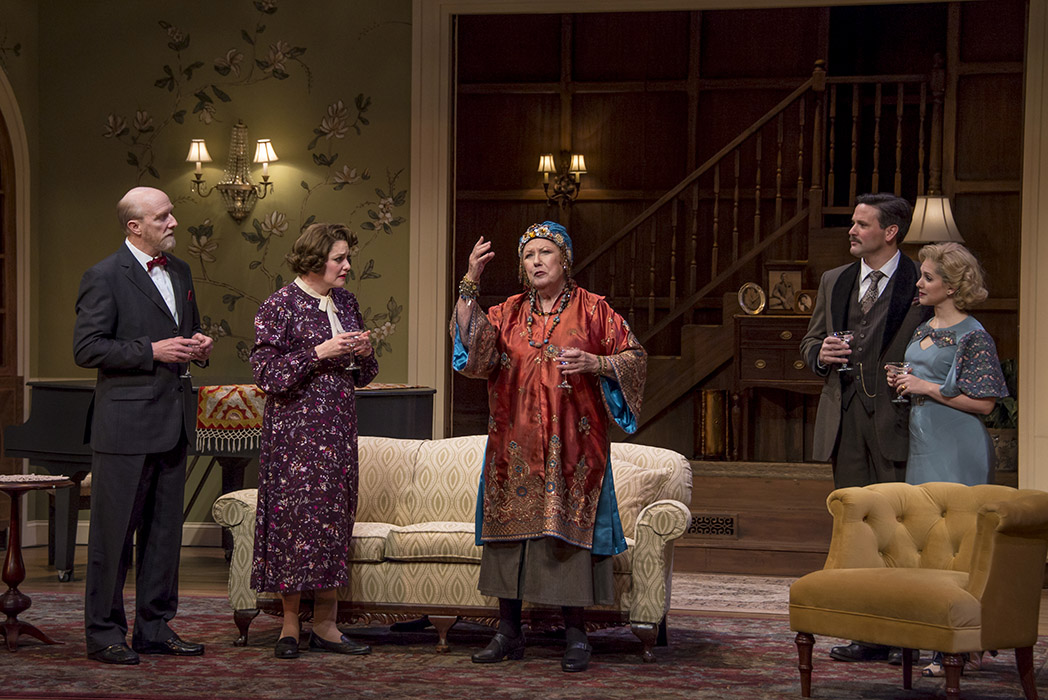“Anybody can write books, but it takes an artist to make a dry martini that’s dry enough.”
—Madame Arcati, Noël Coward’s Blithe Spirit
Pass on the dry martinis like those being served quite generously in Blithe Spirit, the current production at Clarence Brown Theatre—you’ll want all of your wits about you to catch every last morsel of the crisp Noël Coward dialog in this wildly entertaining British drawing room comedy. Nor will you need to imbibe anything in order to admire this marvelous CBT cast and clever production.
Written in 1941 during the dark days of World War II, Coward’s intent with Blithe Spirit was, of course, levity at a time when the realities of death and dying were first-hand subjects for the British population. As it turned out, though, Blithe Spirit’s comic treatment of a writer’s late ex-wife coming back as a ghost to haunt him and his current marriage was a bit of metaphoric hair-of-the-dog for London theatre-goers. Timely, too, was the play’s depiction of challenged marriages, certainly a reminder of the war’s effect on couples and relationships. With the benefit of time and distance, we also get a glimpse of the playwright’s own feeling about romantic relationships.
Director Sharon Ott and her creative team have created a stunning environment for the production, a lavishly detailed, country house drawing room set for the Condomines—Charles, a successful novelist (Brian Gligor), and the beautiful, but insistent, second Mrs. Condomine, Ruth (Christine Sage). Charles’ first wife, Elvira (Katie Cunningham)—gone, but not from Charles’ memory—passed away seven years ago—we are told—not from the pneumonia that she was recovering from, but from a comically ironic heart attack brought on by laughing at a BBC radio program.

Dry martinis are made with abundance and consumed with relish as the bantering Charles and Ruth await their dinner guests for the evening: a local couple, the solid Dr. Bradman (Jed Diamond) and his cutely chirpy wife (Laura Beth Wells), and the real object of the evening, a colorfully functioning but definitely eccentric medium, Madame Arcati (Carol Mayo Jenkins). Charles’ hidden intention is to have Madame Arcati conduct an after-dinner seance so as to glean some methods and trade jargon for a novel he is writing. As one might expect, the seance goes horribly wrong and Elvira, the ex-wife, is materialized, but only as a vision Charles—and the audience—can see.
Intriguing characters with flaws and eccentricities are a necessity of drawing room comedies and this cast really exploits Coward’s crisp and witty characterizations. Gligor allows Charles’ affluent charm and composure to dissolve into a marvelous exasperation when faced with the demands of Ruth and Elvira, revealing his underlying self-centeredness and selfishness. Ultimately, we get a glimpse of his desire to be free of women—and their demands on him—altogether. Sage’s Ruth is mostly unforgiving in her demands on Charles, couching them in witty, but cutting repartee. Cunningham is comically ethereal as Elvira in a performance that is a masterpiece of movement and attitude, slowly revealing her own ghostly agenda made possible by her involuntary return to the physical world. Clearly, the afterlife is so boring—but even ghosts can make unfortunate miscalculations.

In what can arguably be termed perfect casting, Carol Mayo Jenkins appeared as the colorful Madame Arcati. Meandering her way through the details and trivia of her psychic business that the playwright lavished on her character, Jenkins has drawn yet another detailed portrayal, seducing the audience with the beauty of language delivery, as well as presenting a visual character that commands the stage.
Domestic settings always seem to call for a well-intentioned, but clumsy, servant anxiously balancing trays of glassware and somehow being mysteriously pivotal to the plot. A marvelous Madeleine Rowe fills that role here as the Condomines’ struggling maid, Edith, who makes a simple walk across the room into a perilous journey.
Almost as a character unto itself is this production’s physical environment and stagecraft. Designed by Ron Keller, the set is not only visually stunning, but offers the director and actors a perfect triangle within which to move the action. Lighting designer Maranda DeBusk has completed the look with warmth and separation that is almost a metaphor for the crisp dialog. In addition, the production has extensively used lighting along with makeup and wardrobe to give an ethereal and otherworldly appearance to Elvira (and, spoiler alert, to anyone else who should so end up!). Margo Birdwhistell’s costumes for the ladies, especially Madame Arcati, were deliciously eye-catching and character-defining. My one caveat from opening night: stagecraft “magic” works best when you can’t see the mechanics of it. The spirits will agree, I am sure.








